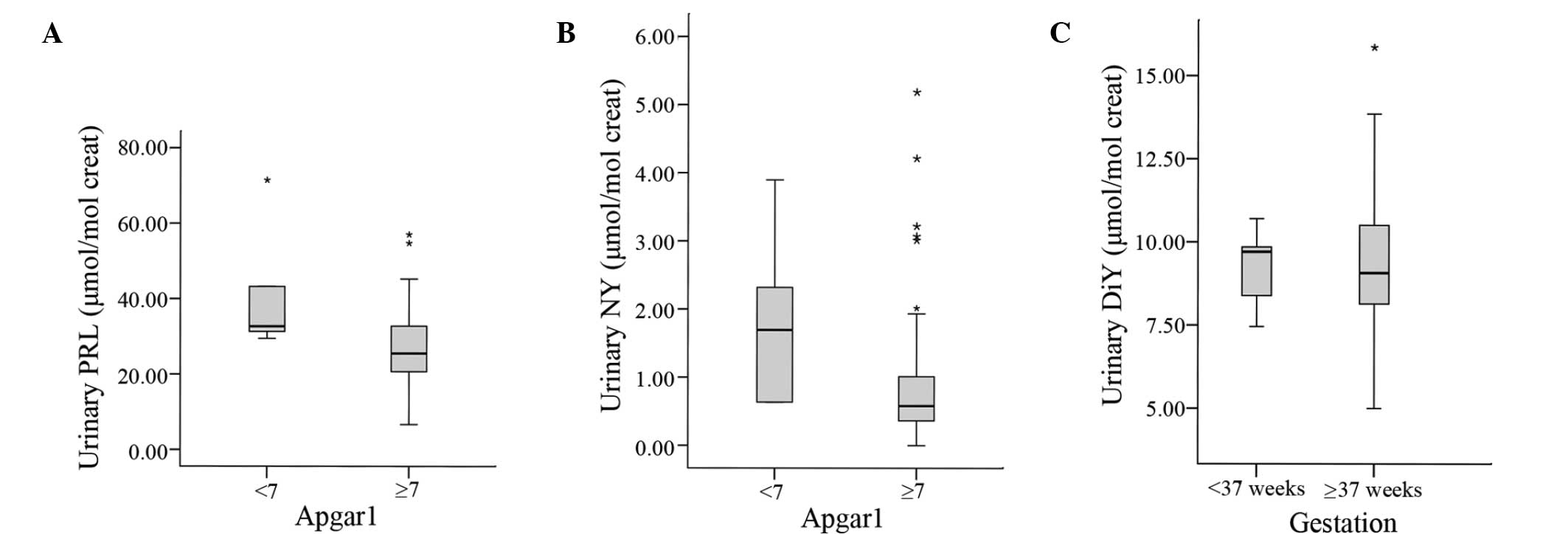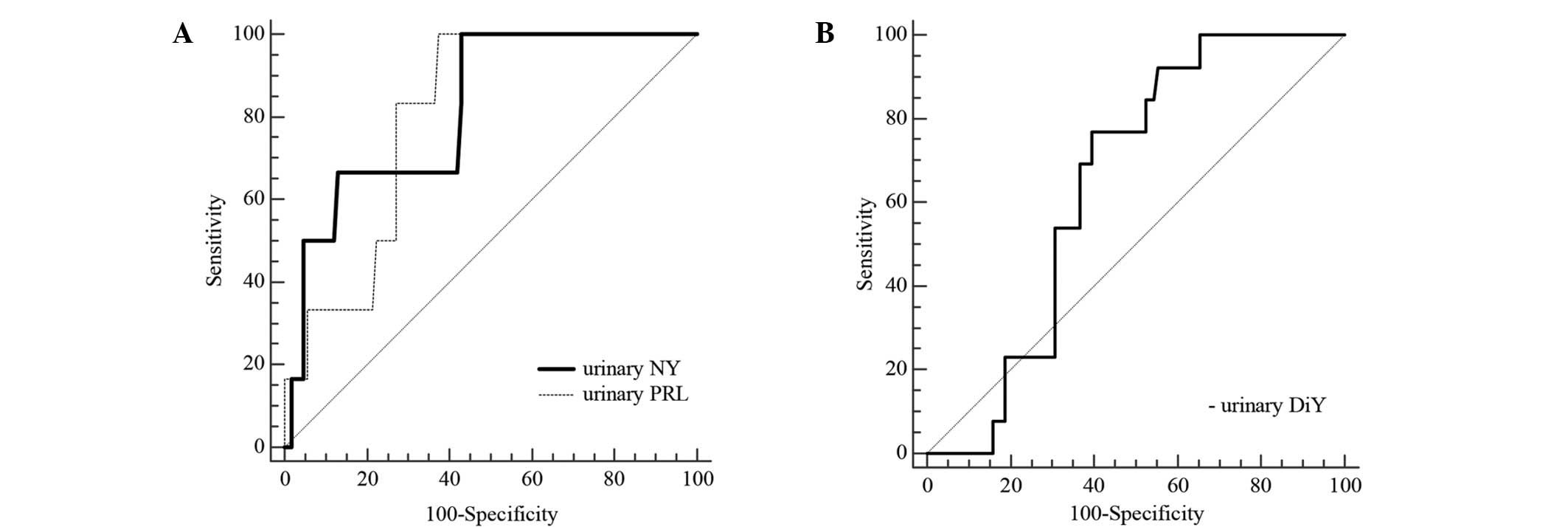|
1
|
Jauniaux E, Poston L and Burton GJ:
Placental-related diseases of pregnancy: Involvement of oxidative
stress and implications in human evolution. Hum Reprod Update.
12:747–755. 2006. View Article : Google Scholar : PubMed/NCBI
|
|
2
|
Myatt L and Cui XL: Oxidative stress in
placenta. Histochem Cell Biol. 122:369–382. 2004. View Article : Google Scholar : PubMed/NCBI
|
|
3
|
Toescu V, Nuttall S, Martin U, Kendall M
and Dunne F: Oxidative stress and normal pregnancy. Clin Endocrinol
(Oxf). 57:609–613. 2002. View Article : Google Scholar : PubMed/NCBI
|
|
4
|
Hung TH, Lo LM, Chiu TH, Li MJ, Yeh YL,
Chen SF and Hsieh TT: A Longitudinal study of oxidative stress and
antioxidant status in women with uncomplicated pregnancies
throughout gestation. Reprod Sci. 17:401–409. 2010. View Article : Google Scholar : PubMed/NCBI
|
|
5
|
Osredkar J: Oxidative stress. Zdrav Vestn.
81:393–406. 2012.(In Slovenian).
|
|
6
|
Sies H: Oxidative stress: Oxidants and
antioxidants. Exp Physiol. 82:291–295. 1997. View Article : Google Scholar : PubMed/NCBI
|
|
7
|
Burton GJ and Jauniaux E: Oxidative
stress. Best Pract Res Clin Obstet Gynaecol. 25:287–299. 2011.
View Article : Google Scholar : PubMed/NCBI
|
|
8
|
Halliwell B and Chirico S: Lipid
peroxidation: Its mechanism, measurement and significance. Am J
Clin Nutr. 57(Suppl 5): 715S–724S. 1993.PubMed/NCBI
|
|
9
|
Kato Y and Osawa T: Detection of
lipid-lysine amide-type adduct as a marker of PUFA oxidation and
its applications. Arch Biochem Biophys. 501:182–187. 2010.
View Article : Google Scholar : PubMed/NCBI
|
|
10
|
Kato Y and Osawa T: Detection of a
lipid-lysine adduct family with an amide bond as the linkage: Novel
markers for lipid-derived protein modifications. Methods Mol Biol.
580:129–141. 2009.PubMed/NCBI
|
|
11
|
Hisaka S, Kato Y, Kitamoto N, Yoshida A,
Kubushiro Y, Naito M and Osawa T: Chemical and immunochemical
identification of propanoyllysine derived from oxidized n-3
polyunsaturated fatty acid. Free Radic Biol Med. 46:1463–1471.
2009. View Article : Google Scholar : PubMed/NCBI
|
|
12
|
Kato Y, Yoshida A, Naito M, Kawai Y, Tsuji
K, Kitamura M, Kitamoto N and Osawa T: Identification and
quantification of N(epsilon)-(Hexanoyl)lysine in human urine by
liquid chromatography/tandem mass spectrometry. Free Radic Biol
Med. 37:1864–1874. 2004. View Article : Google Scholar : PubMed/NCBI
|
|
13
|
Tokuda F, Sando Y, Matsui H and Yokoyama
T: N epsilon-(hexanoyl) lysine, a new oxidative stress marker, is
increased in metabolic syndrome, but not in obstructive sleep
apnea. Am J Med Sci. 338:127–133. 2009. View Article : Google Scholar : PubMed/NCBI
|
|
14
|
Kageyama Y, Takahashi M, Nagafusa T,
Torikai E and Nagano A: Etanercept reduces the oxidative stress
marker levels in patients with rheumatoid arthritis. Rheumatol Int.
28:245–251. 2008. View Article : Google Scholar : PubMed/NCBI
|
|
15
|
Shimizu K, Ogawa F, Akiyama Y, Muroi E,
Yoshizaki A, Iwata Y, Komura K, Bae S and Sato S: Increased serum
levels of N(epsilon)-(hexanoyl)lysine, a new marker of oxidative
stress, in systemic sclerosis. J Rheumatol. 35:2214–2219. 2008.
View Article : Google Scholar : PubMed/NCBI
|
|
16
|
Kato Y, Dozaki N, Nakamura T, Kitamoto N,
Yoshida A, Naito M, Kitamura M and Osawa T: Quantification of
modified tyrosines in healthy and diabetic human urine using liquid
chromatography/tandem mass spectrometry. J Clin Biochem Nutr.
44:67–78. 2009. View Article : Google Scholar : PubMed/NCBI
|
|
17
|
DiMarco T and Giulivi C: Current
analytical methods for the detection of dityrosine, a biomarker of
oxidative stress, in biological samples. Mass Spectrom Rev.
26:108–120. 2007. View Article : Google Scholar : PubMed/NCBI
|
|
18
|
Giulivi C, Traaseth NJ and Davies JA:
Tyrosine oxidation products: Analysis and biological relevance.
Amino Acids. 25:227–232. 2003. View Article : Google Scholar : PubMed/NCBI
|
|
19
|
Chen X and Scholl TO: Oxidative stress:
Changes in pregnancy and with gestational diabetes mellitus. Curr
Diab Rep. 5:282–288. 2005. View Article : Google Scholar : PubMed/NCBI
|
|
20
|
Min J, Park B, Kim YJ, Lee H, Ha E and
Park H: Effect of oxidative stress on birth size: Consideration of
window from mid pregnancy to delivery. Placenta. 30:418–423. 2009.
View Article : Google Scholar : PubMed/NCBI
|
|
21
|
Longini M, Perrone S, Kenanidis A, Vezzosi
P, Marzocchi B, Petraglia F, Centini G and Buonocore G:
Isoprostanes in amniotic fluid: A predictive marker for fetal
growth restriction in pregnancy. Free Radic Biol Med. 38:1537–1541.
2005. View Article : Google Scholar : PubMed/NCBI
|
|
22
|
Stein TP, Scholl TO, Schulter MD, Leskiw
MJ, Chen X, Spur BW and Rodriguez A: Oxidative stress early in
pregnancy and pregnancy outcome. Free Radic Res. 42:841–848. 2008.
View Article : Google Scholar : PubMed/NCBI
|
|
23
|
Hsieh TT, Chen SF, Lo LM, Li MJ, Yeh YL
and Hung TH: The association between maternal oxidative stress at
mid-gestation and subsequent pregnancy complications. Reprod Sci.
19:505–512. 2012. View Article : Google Scholar : PubMed/NCBI
|
|
24
|
Apgar V: A proposal for a new method of
evaluation of the newborn infant. Originally published in July
1953, volume 32, pages 250–259. Anesth Analg. 120:1056–1059. 2015.
View Article : Google Scholar : PubMed/NCBI
|
|
25
|
Orhan H, Coolen S and Meerman JH:
Quantification of urinary o,o-dityrosine, a biomarker of oxidative
damage to proteins, by high performance liquid chromatography with
triple quadrupole tandem mass spectrometry. A comparison with
ion-trap tandem mass spectrometry. J Chromatogr B Analyt Technol
Biomed Life Sci. 827:104–108. 2005. View Article : Google Scholar : PubMed/NCBI
|
|
26
|
Tsikas D, Mitschke A, Suchy MT, Gutzki FM
and Stichtenoth DO: Determination of 3-nitrotyrosine in human urine
at the basal state by gas chromatography-tandem mass spectrometry
and evaluation of the excretion after oral intake. J Chromatogr B
Analyt Technol Biomed Life Sci. 827:146–156. 2005. View Article : Google Scholar : PubMed/NCBI
|
|
27
|
Figueras F, Meler E, Eixarch E, Francis A,
Coll O, Gratacos E and Gardosi J: Association of smoking during
pregnancy and fetal growth restriction: Subgroups of higher
susceptibility. Eur J Obstet Gynecol Reprod Biol. 138:171–175.
2008. View Article : Google Scholar : PubMed/NCBI
|
|
28
|
Raatikainen K, Huurinainen P and Heinonen
S: Smoking in early gestation or through pregnancy: A decision
crucial to pregnancy outcome. Prev Med. 44:59–63. 2007. View Article : Google Scholar : PubMed/NCBI
|
|
29
|
Windham GC, Hopkins B, Fenster L and Swan
SH: Prenatal active or passive tobacco smoke exposure and the risk
of preterm delivery or low birth weight. Epidemiology. 11:427–433.
2000. View Article : Google Scholar : PubMed/NCBI
|
|
30
|
Yerushalmy J: The relationship of parents'
cigarette smoking to outcome of pregnancy-implication as to the
problem of inferring causation from observed associations. Am J
Epidemiol. 93:443–456. 1971.PubMed/NCBI
|
|
31
|
Seet RC, Lee CY, Loke WM, Huang SH, Huang
H, Looi WF, Chew ES, Quek AM, Lim EC and Halliwell B: Biomarkers of
oxidative damage in cigarette smokers: Which biomarkers might
reflect acute versus chronic oxidative stress? Free Radic Biol Med.
50:1787–1793. 2011. View Article : Google Scholar : PubMed/NCBI
|
|
32
|
Campos C, Guzmán R, López-Fernández E and
Casado Á: Urinary biomarkers of oxidative/nitrosative stress in
healthy smokers. Inhal Toxicol. 23:148–156. 2011. View Article : Google Scholar : PubMed/NCBI
|
|
33
|
Sakano N, Takahashi N, Wang DH, Sauriasari
R, Takemoto K, Kanbara S, Sato Y, Takigawa T, Takaki J and Ogino K:
Plasma 3-nitrotyrosine, urinary 8-isoprostane and 8-OHdG among
healthy Japanese people. Free Radic Res. 43:183–192. 2009.
View Article : Google Scholar : PubMed/NCBI
|
|
34
|
Zhang WZ, Lang C and Kaye DM:
Determination of plasma free 3-nitrotyrosine and tyrosine by
reversed-phase liquid chromatography with
4-fluoro-7-nitrobenzofurazan derivatization. Biomed Chromatogr.
21:273–278. 2007. View
Article : Google Scholar : PubMed/NCBI
|
|
35
|
Rummenie VT, Matsumoto Y, Dogru M, Wang Y,
Hu Y, Ward SK, Igarashi A, Wakamatsu T, Ibrahim O, Goto E, et al:
Tear cytokine and ocular surface alterations following brief
passive cigarette smoke exposure. Cytokine. 43:200–208. 2008.
View Article : Google Scholar : PubMed/NCBI
|
|
36
|
Malti N, Merzouk H, Merzouk SA, Loukidi B,
Karaouzene N, Malti A and Narce M: Oxidative stress and maternal
obesity: Feto-placental unit interaction. Placenta. 35:411–416.
2014. View Article : Google Scholar : PubMed/NCBI
|
|
37
|
Keaney JF Jr..Larson MG, Vasan RS, Wilson
PW, Lipinska I, Corey D, Massaro JM, Sutherland P, Vita JA and
Benjamin EJ: Framingham Study: Obesity and systemic oxidant stress:
Clinical correlates of oxidative stress in the Framingham Study.
Arteroscler Thromb Vasc Biol. 23:434–439. 2003. View Article : Google Scholar
|
|
38
|
Fernández-Sánchez A, Madrigal-Santillán E,
Bautista M, Esquivel-Soto J, Morales-González A, Esquivel-Chirino
C, Durante-Montiel I, Sánchez-Rivera G, Valadez-Vega C and
Morales-González JA: Inflammation, oxidative stress and obesity.
Int J Mol Sci. 12:3117–3132. 2011. View Article : Google Scholar : PubMed/NCBI
|
|
39
|
Jacob KD, Hooten Noren N, Trzeciak AR and
Evans MK: Markers of oxidant stress that is clinically relevant in
aging and age-related disease. Mech Ageing Dev. 134:139–157. 2013.
View Article : Google Scholar : PubMed/NCBI
|
|
40
|
Reyes MR, Sifuentes-Alvarez A and Lazalde
B: Estrogens are potentially the only steroids with an antioxidant
role in pregnancy: In vitro evidence. Acta Obstet Gynecol
Scand. 85:1090–1093. 2006. View Article : Google Scholar : PubMed/NCBI
|
|
41
|
Casey BM, McIntire DD and Leveno KJ: The
continuing value of the Apgar score for the assessment of newborn
infants. N Engl J Med. 344:467–471. 2001. View Article : Google Scholar : PubMed/NCBI
|
















